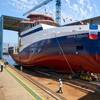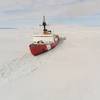WASHINGTON, DC -- Naval Sea Systems Command (NAVSEA) is currently directing
a field demonstration of the Man Overboard Indicator (MOBI) system that will improve the safety of Sailors involved in operational situations that create a high potential for personnel to fall overboard.
MOBI is a personal water or manual activated alarm system that aids in the detection, location, and recovery of sailors who become a man overboard victim.
Naval Surface Warfare Center (NSWC) Dahlgren's Coastal Systems Station in Panama City, Fla. is serving as NAVSEA's technical agent for this
demonstration. Its role is to validate the operational requirement for the device and identify what modifications, if any, are needed to improve its effectiveness.
The MOBI system consists of a transmitter, receiver, direction finder, and associated antennas. The MOBI transmitter, which includes an 18-inch flexible antenna, can be installed in the MK-1 life preserver pocket, attached to the Sterns lifejacket, or be worn in a carrier on the
Sailor's belt. If a Sailor goes into the ocean, the transmitter activates and sends a signal to a receiver aboard ship. This signal identifies the Sailor and locates the Sailor with its radio direction finder.
The field demonstration is being conducted on approximately 20 selected ships making up the USS George Washington (CVN 73) Battle Group and the
USS Nassau (LHA 4) Amphibious Ready Group on the East Coast, and the USS Abraham Lincoln (CVN 72) Battle Group and USS Belleau Wood (LHA 3) Amphibious Ready Group on the West Coast. Each ship in the demonstration is outfitted with one alarm receiver, two radio direction finders, and a
number of transmitters depending upon the crew size. Upon completion of the evaluation, NAVSEA, in consultation with the Chief of Naval Operations
and the Fleet Commanders, will make the final decision as to whether the device should be implemented fleet-wide. This decision will be made in 2003.
Sponsored Content
Safer Starts Here: Build Ships, Protect Crews

Subscribe for
Maritime Reporter E-News
Maritime Reporter E-News is the maritime industry's largest circulation and most authoritative ENews Service, delivered to your Email five times per week











